I love the area of the Marais, in Paris.
It is a melting pot of people and cultures. Gay people, Jewish people, French people, locals, tourists and just … people.
In the narrow busy streets, Jewish kosher shops, rub shoulders with gay bars, independent clothing stores, French boulangeries, cafes, restaurants and museums. All crammed into an area, of about 2500 square metres. It’s vibrant, colourful and friendly.
Since I arrived in Paris, I have been walking the streets of the Marais everyday, but normally, I am rushing to the theatre, to dinner, to the boulangerie or supermarket.
Today, I decided to be the quintessential flâneur, that is, to take my time and stroll the streets of my neighbourhood and a little beyond.
Leaving the right bank, I crossed the river, to the smaller, of the two natural islands in Paris; Île Saint-Louis, walking through the centre of the island, heading for Place de la Bastille, and returning to the right bank. This is where, I wanted to begin my journey, working my way back, to the Marais.
Île Saint-Louis is a charming island and not as popular as the neighbouring Île de la Cité, which boasts the Notre Dame and therefore, has it’s droves of tourists. Île Saint-Louis has a more relaxed atmosphere.
Arriving on the right bank, from the Île Saint-Louis, and wandering up to Place de la Bastille, I noticed that the Christmas decorations were in the process of being removed and the large roundabout, was slowly, coming back to normal.
Not far from Place de la Bastille, is the colonnaded square of Place des Vosges. It features a long, and famous history. Originally, built for aristocrats and later, was the wedding venue for Louis XIII and Anne of Austria.
Onlookers cheered on, as a three day marital tournament took place; men on horses, running towards one another at break-neck speed, with large swords! It makes the bridal shower, look lame, in comparison.
Victor Hugo, author of The Hunchback of Notre Dame, rented an apartment in Place des Vosges, with his wife and children, when he wrote Les Miserables. The free museum, dedicated to him, is well worth a visit and offers lovely views of the park below.
Today, the lovely square is making new history. Cafes and artists studios line the street level, and homeless people, take shelter under the beautiful vaulted archways.
Slipping out of the square, of Place des Vosges, through a narrow doorway, I entered the garden of Hôtel de Sully. During the 1600’s, Hôtel de Sully was built for a financer and heavy gambler, (maybe the same thing). The story goes he lost his fortune and sold the building to Duc de Sully, and this, is where it gets it’s name.
Hotel de Sens, was next on my list, but the renovations and scaffolding surrounding it made me wish I had taken photographs last year, when it was free of the clutter. However, the gardens are untouched and the old street signs, marking the old divisions of Paris, were worth the passby.
This brought me back to the heart of the Marais, Rue Rosiers and the Jewish Quarter or the Pletzl, as it is known in Yiddish.
The City of Paris has erected, a huge, all weather, touch screen monitor, commemorating the history of the area. Past residents, including a 101 year old woman, tells her story, of when she was a child, during the war. A man recounts, when he was a young boy, stealing a pretzel bread as he ran past a bakery, trying to survive the horrors and hunger of those years gone by.
Recently, I joked with a friend, if you look up, or point a camera at something, almost instantaneously, you can be surrounded by tourists and people, wandering what you are looking at.
As I touched the screen, situated opposite the bright yellow bakery; Sacha Finkelsztajn, a crowd gathered to watch and listen. I think this is a great initiative and can teach locals and tourists about the wide and varied culture of the area.
Starting to feel a little weary and cold, and only 1 minute away from my favourite café, I stopped for a break.
Didier, smeared a lavish amount of melting chocolate around the inside of a cup and placed it in on the bar in front of me, with a jug of hot milk.
As I stirred the milk, into the cup of melting chocolate, and wrapped my cold hands around it, allowing it to bring some life back into my fingers, I let my muscles relax.
From within the warmth of the bar, sipping on my chocolat chaud à l’ancienne, I observed other flaneurs, exploring the streets of the Marais.
Reading about a family run restaurant, I learned it was a favourite with local Parisians. It is very cheap, no frills, home style cooking and I was keen to test it out. I invited The New Yorker to join me, it was a strange experience. .
Arriving early to a Parisin restaurant, can give you a sense, that it is not well liked or popular. When I entered through the main door, with not a soul about, except two wait staff, possibly family members, I was a little nervous and asked if they were open.
Yes, they were and we were lead to a room, occupied by a small amount of people, It was however, a much earlier time, than the French prefer to eat and it was, a Monday night.
From what I could hear, it was French speaking French and French speaking English with fellow diners. This made me comfortable. Parisians were bringing their English speaking friends here for a reason.
In a city that is over ran with tourists from all around the world, my opinion is that Parisians are very tolerant.
When Parisians commute, on the busy metro underground network, the last thing they need, is for a tourist; stopping in their tracks, in the middle of a corridor, to read a map or have chat. The Parisian, stylishly, skirts around them and rushes to work, maybe there is a raised eyebrow, or a little exhaling from the cheeks, mostly, it goes unnoticed.
In a busy Parisian bistro, where the waiters are ran off their feet, they are expected to speak a multitude of languages, ranging from English, Japanese, Russian, Italian or whatever it may be. They try their best. After that, they must swing back to French for the locals and their colleagues. They also need to ensure, that the Parisian diner, on their lunch break, are served promptly, so they can return to work.
Generally, the Parisian waiter, is a professional. Not an underpaid worker, who has to rely on being over zealous, to get a tip to make ends meet, or a university student, begrudgingly, taking on the work to supplement a university degree.
Therefore, the Parisian waiter, is ready to take your order, they expect it to be quick and snappy, others are also waiting to be served.
Bring the tourist, back into the mix … on holidays, all the time in the world to spare, and sometimes; no grasp of the French culture or language and wants to know, if, they can have tomato sauce, with their Canard à l’Orange.
Perhaps you are getting the picture and everyone knows the old saying …. when in Rome. This does not seem to count in Paris. The Italians want their pasta, the Americans want their long deliberated service, and ‘stuff’ on the side and the Australians want their rowdy bars.
Of course, this is a huge generalisation, but it happens, and it is noticed.
In Australia, we have many Asian tourists. What I don’t see is, Australians breaking into Vietnamese, Japanese, Thai, or Chinese, to communicate with the visiting tourist.
So, why is it, that a lot of people, seem to expect it in Paris?
If this makes me; the visiting Australian upset. I wonder how the Parisians feel?
But, I digress.
We entered a quiet, family run restaurant. The New Yorkers quiche was definitely burnt on the base. She sent it back. Another arrived, slightly burned on the base also. This was the second burnt quiche I had witnessed, on this trip to Paris, in a matter of days.
It put a sour edge on the night, I am sure in America, there would have been a scene. In Australia, it would have been sent back and a refund would have been demanded, still, not without a challenge.
Our main meals were delicious, I had a huge piece of duck in prune sauce and The New Yorker had porc, with potatoes on the side. I tried to move on.
By the end of the dinner, I had decided to say something, about The New Yorker’s quiche. The owner, was so incredibly apologetic and anxious, that I wound up feeling bad.
It is a family business, they made a mistake he offered, but if they knew their mistake, why serve it, I pushed.
By the end of the conversation, I could see that perhaps the down turn on the economy was taking it’s toll. At times, I thought he was going to burst into tears.
Many, ‘I am sorry”s flew around from both of us and I left, the family ran restaurant feeling, deflated and mean. He was genuinely concerned and the lack of culture, language and understanding stood in the way, of good communication.
After dinner, alone, I walked the streets of my neighbourhood; the Marais, took time lapse photos and despite the New Yorker’s burnt quiche, I still love the Marais and Paris.

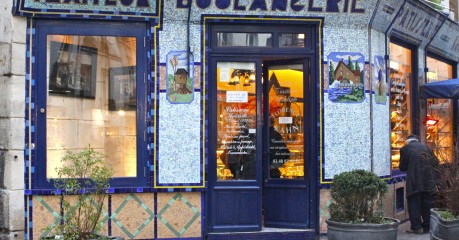
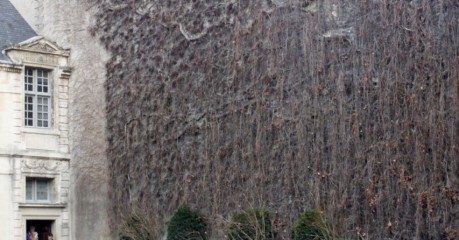
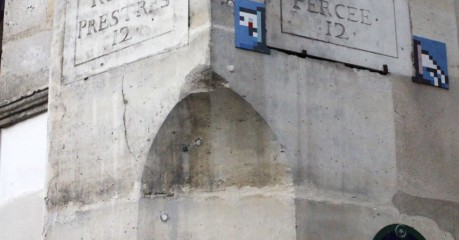

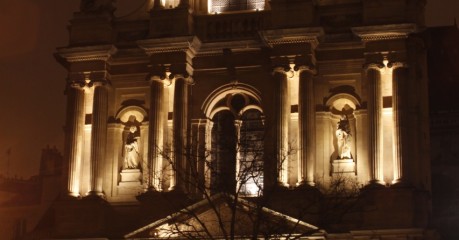
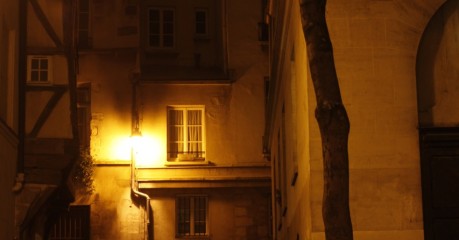
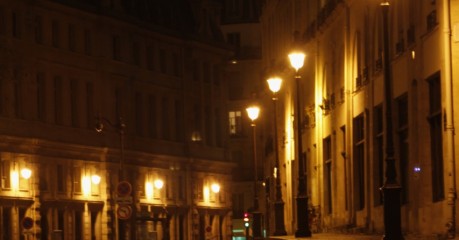
One Response to Strolling Around the Marais